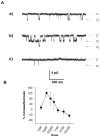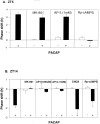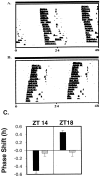Pituitary adenylate cyclase activating peptide phase shifts circadian rhythms in a manner similar to light
- PMID: 10414992
- PMCID: PMC6782812
- DOI: 10.1523/JNEUROSCI.19-15-06637.1999
Pituitary adenylate cyclase activating peptide phase shifts circadian rhythms in a manner similar to light
Abstract
The endogenous circadian pacemaker in mammals is located in the suprachiasmatic nuclei (SCN) of the hypothalamus. Various cues can reset circadian rhythm phase, thereby entraining the internal rhythm to the environmental cycle, and these effects can be investigated using an in vitro method to measure phase shifts of the SCN. Although pituitary adenylate cyclase activating peptide (PACAP) is localized in retinal inputs to the SCN, it has been reported to alter clock phase only during the subjective day (Hannibal et al., 1997), whereas light alters phase only in the subjective night. In this study we show that PACAP can reset the clock in the photic pattern during the subjective night when applied in 10 pM to 1 nM doses. This appears to be mediated via a glutamatergic mechanism, possibly by potentiation of NMDA currents as is seen at 10-100 pM. Given at higher doses (>10 nM), PACAP shifts in the subjective day, apparently via activation of adenylate cyclase and increased intracellular cAMP. These results indicate dose and phase specificity of the effects of PACAP, and a new role as a transmitter in the retinohypothalamic tract.
Figures




Similar articles
-
Light-induced phase shift in the Syrian hamster (Mesocricetus auratus) is attenuated by the PACAP receptor antagonist PACAP6-38 or PACAP immunoneutralization.Eur J Neurosci. 2003 Nov;18(9):2552-62. doi: 10.1046/j.1460-9568.2003.03000.x. Eur J Neurosci. 2003. PMID: 14622156
-
Pituitary adenylate cyclase-activating polypeptide produces a phase shift associated with induction of mPer expression in the mouse suprachiasmatic nucleus.Neuroscience. 2002;113(1):37-45. doi: 10.1016/s0306-4522(02)00148-3. Neuroscience. 2002. PMID: 12123682
-
Homer-1 mRNA in the rat suprachiasmatic nucleus is regulated differentially by the retinohypothalamic tract transmitters pituitary adenylate cyclase activating polypeptide and glutamate at time points where light phase-shifts the endogenous rhythm.Brain Res Mol Brain Res. 2002 Sep 30;105(1-2):79-85. doi: 10.1016/s0169-328x(02)00395-9. Brain Res Mol Brain Res. 2002. PMID: 12399110
-
An essential role for peptidergic signalling in the control of circadian rhythms in the suprachiasmatic nuclei.J Neuroendocrinol. 2003 Apr;15(4):335-8. doi: 10.1046/j.1365-2826.2003.01005.x. J Neuroendocrinol. 2003. PMID: 12622830 Review.
-
Suprachiasmatic nucleus: the brain's circadian clock.Recent Prog Horm Res. 1999;54:33-58; discussion 58-9. Recent Prog Horm Res. 1999. PMID: 10548871 Review.
Cited by
-
The sleep-promoting and hypothermic effects of glycine are mediated by NMDA receptors in the suprachiasmatic nucleus.Neuropsychopharmacology. 2015 May;40(6):1405-16. doi: 10.1038/npp.2014.326. Epub 2014 Dec 23. Neuropsychopharmacology. 2015. PMID: 25533534 Free PMC article.
-
Comparative Neurology of Circadian Photoreception: The Retinohypothalamic Tract (RHT) in Sighted and Naturally Blind Mammals.Front Neurosci. 2021 May 14;15:640113. doi: 10.3389/fnins.2021.640113. eCollection 2021. Front Neurosci. 2021. PMID: 34054403 Free PMC article. Review.
-
Effects of PACAP on the circadian changes of signaling pathways in chicken pinealocytes.J Mol Neurosci. 2008 Nov;36(1-3):220-6. doi: 10.1007/s12031-008-9112-4. Epub 2008 Jul 1. J Mol Neurosci. 2008. PMID: 18592414
-
Developmental alcohol exposure alters light-induced phase shifts of the circadian activity rhythm in rats.Alcohol Clin Exp Res. 2004 Jul;28(7):1020-7. doi: 10.1097/01.alc.0000130807.21020.1b. Alcohol Clin Exp Res. 2004. PMID: 15252288 Free PMC article.
-
Vasoactive intestinal polypeptide requires parallel changes in adenylate cyclase and phospholipase C to entrain circadian rhythms to a predictable phase.J Neurophysiol. 2011 May;105(5):2289-96. doi: 10.1152/jn.00966.2010. Epub 2011 Mar 9. J Neurophysiol. 2011. PMID: 21389307 Free PMC article.
References
-
- Arimura A, Said SI. VIP, PACAP, and related peptides. Second International Symposium, Annals of the New York Academy of Science, Vol 805. New York Academy of Science; New York: 1996.
-
- Biello SM. Neuropeptide Y and non-photic phase shifts. University of Toronto, PhD thesis. 1995.
-
- Ebling FJ. The role of glutamate in the photic regulation of the suprachiasmatic nucleus. Prog Neurobiol. 1996;50:109–132. - PubMed
-
- Fukuhara C, Suzuki N, Matsumoto Y, Nakayam Y, Aoki K, Tsujimoto G, Inouye S-IT, Masuo Y. Day-night variation of pituitary adenylate cyclase-activating polypeptide (PACAP) level in the rat suprachiasmatic nucleus. Neurosci Lett. 1997;229:49–52. - PubMed
-
- Fukuhara C, Inouye S-IT, Matsumoto Y, Tsujimoto G, Aoki K, Masuo Y. Pituitary adenylate cyclase-activating polypeptide rhythm in the rat pineal gland. Neurosci Lett. 1998;241:115–118. - PubMed
Publication types
MeSH terms
Substances
LinkOut - more resources
Full Text Sources
